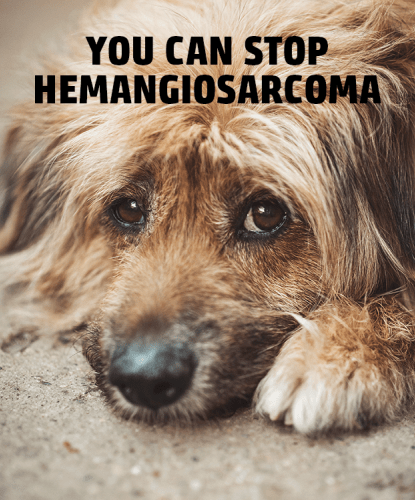
April 8, 2024 — Hemangiosarcoma is a common and deadly cancer in dogs. The cancer tends to grow and spread rapidly, rarely giving the owner any clue their dog is harboring a fatal disease – until it suddenly strikes. On average, a beloved dog succumbs to hemangiosarcoma every two minutes.
Knowing more about how this cancer develops and learning to recognize the subtle signs of the disease are essential for owners to spot a potential problem and know if hemangiosarcoma affects their dog. Check out our hemangiosarcoma resources page to learn more about what the Foundation is doing to address this devastating disease and how you can help!
Hemangiosarcomas Often Occur in Sites with A Rich Blood Supply
There is growing evidence that hemangiosarcoma cancer cells originate in the bone marrow and rapidly spread to other locations in the body. Experts often first detect hemangiosarcoma in the heart and spleen, which are the two most common sites for this type of tumor. This propensity for the heart and spleen is the reason these tumors are so deadly.
Hemangiosarcomas can suddenly rupture, causing massive blood loss and forcing owners and veterinarians to make difficult decisions within minutes of diagnosis.
Hemangiosarcoma is a Disease of Larger-breed, Older Dogs
Hemangiosarcoma most commonly affects:
- Middle-aged to older dogs
- German shepherds, golden retrievers, Portuguese water dogs and Labrador retrievers
- Slightly more males than females (in some studies)
It’s important to remember that although hemangiosarcoma is more common in some breeds of dogs, any dog can be affected!
Unfortunately, no clinical signs (symptoms) are classic for hemangiosarcoma other than sudden, profound internal bleeding. Because this cancer doesn’t cause significant pain until a rupture occurs, few dogs show any sign of discomfort. Other clinical signs reported by owners include:
- Intermittent lethargy or fatigue
- Anorexia
- Panting
- Sudden collapse
- Sudden death
Most pet owners are quick to act in sudden collapse, and time is of the essence in cases of hemangiosarcoma. These are true medical emergencies, and many patients require immediate surgery to remove the bleeding mass (if possible), followed by supportive care to survive.
Long-term Survival Statistics Are Bleak
Even when a tumor is quickly detected and removed, the outlook for dogs with hemangiosarcoma is grim. Statistics show that:
- Average survival time with surgery alone is one to three months
- Average survival time with surgery and chemotherapy is five to seven months
- 90% of dogs are deceased one- year post-diagnosis despite surgery and chemotherapy, with almost 100% mortality two years post-diagnosis
Survival times have remained static for nearly 30 years, and new treatments are desperately needed. This is where Morris Animal Foundation comes in.
New Ideas and Research On an Old Foe
Many researchers and studies have focused on learning more about this terrible cancer.
New findings reported in the last two years include:
- A recent study focused on small dogs with hemangiosarcoma found similar survival statistics as large-breed dogs with hemangiosarcoma.
- Researchers continue to work on the effect of spay/neuter on the incidence of hemangiosarcoma, but they have not yet reached a definitive conclusion.
- Researchers from North Carolina State University found a higher incidence of the bacteria Bartonella spp. in some dogs with hemangiosarcoma and are doing more studies to clarify their findings.
Results from the Golden Retriever Lifetime Study will be invaluable as we try to answer these critical questions.
How the Golden Retriever Lifetime Study Could Provide Important Clues to Hemangiosarcoma
At the start of the Study, over a decade ago, hemangiosarcoma was identified as a cancer of particular interest. Although we knew it was a common cancer in golden retrievers, as our enrolled hero dogs began to die from cancer, hemangiosarcoma emerged as the most common cause of cancer-related death in our study cohort. Hemangiosarcoma alone contributes to an astounding 70% of cancer-related deaths.
We hope researchers can use our banked samples from dogs with and without hemangiosarcoma to develop early diagnostic tests and understand possible genetic links to this deadly disease. Our team continues to work hard to promote Study data and samples to researchers worldwide, inviting them to submit proposals to learn more about hemangiosarcoma and other cancers in golden retrievers.
The Golden Oldies project, a complementary project to the Golden Retriever Lifetime Study, collected DNA samples from older golden retrievers without cancer. Along with genetic data on dogs enrolled in the Golden Retriever Lifetime study, these datasets provide additional, critically needed information on the underlying genetics of hemangiosarcoma. Findings from these projects could help develop diagnostic tests to identify dogs at risk for hemangiosarcoma and possibly other canine cancers. We recently made this invaluable genetic data available for free to researchers worldwide to help spur even more discoveries.
Improving the Odds for Dogs with Hemangiosarcoma
Morris Animal Foundation has invested more than $3 million in 20+ years of research to improve the quality and duration of life for dogs diagnosed with hemangiosarcoma.
Our funded research has focused on:
- Disease basics – understanding the basic biology of hemangiosarcoma may open the door to new diagnostics, treatments and prevention.
- Overcoming chemotherapy resistance – understanding why hemangiosarcoma becomes drug-resistant could improve treatment success and identify new chemotherapeutic agents.
- Genetic links – studying breeds commonly affected by hemangiosarcoma could lead to new diagnostic testing and clues to genetics' role in developing this disease.
In the fall of 2022, we announced our new Hemangiosarcoma Initiative, and in June 2023, our team welcomed an expert panel to review more than 30 proposals from researchers worldwide. We chose six proposals for funding and added two additional projects in November 2023. Our goal is nothing short of changing the odds for the thousands of dogs diagnosed with this terrible cancer each year.
Science to Save Animals
Without sustained support, we cannot accomplish the science needed to save our dogs from hemangiosarcoma. Until further funding is available, researchers shelve promising research, move to other projects, and reallocate staff.
Science starts with you.
We need your help to keep the momentum we’re building with our Hemangiosarcoma Initiative and all our efforts to stop canine cancer from taking more lives.
Additional Resources
- Hemangiosarcoma Resource Page
- Fresh Scoop Podcast Episode 52: New Ideas on Hemangiosarcoma in Dogs
- TED Talk: Hemangiosarcoma – A Deadly Canine Cancer





